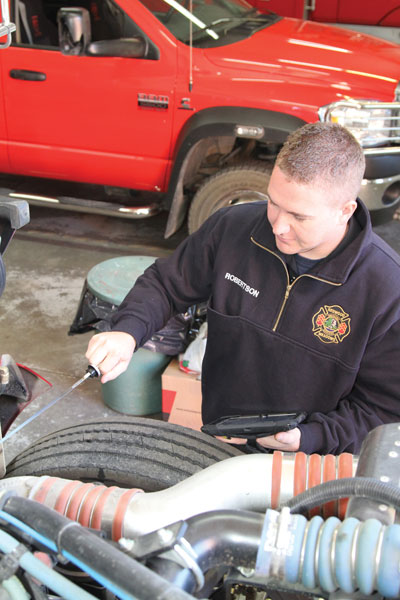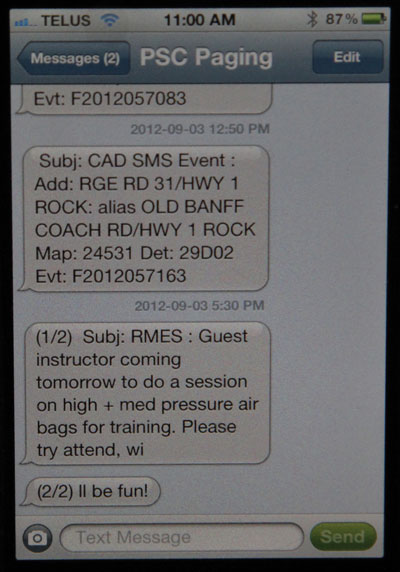
Embracing technology
By Rob Evans
Features Equipment Hot TopicsThere has been considerable debate in the fire service about the use of technology in the fire hall
There has been considerable debate in the fire service about the use of technology in the fire hall, on the trucks, and, in particular, at incidents. While many departments are making use of smartphones and social media, the 36-member Redwood Meadows Emergency Services (RMES) in Alberta and its volunteer members have combined internal expertise with innovation to create apps for iPads and other devices that are helping them do their jobs better.
 |
|
| Redwood Meadows Emergency Services (RMES) Capt./EMT Gary Robertson uses an iPad to complete equipment checks. RMES members have used their technical know-how to save money and implement new systems. Photos by Rob Evans
|
As is the case in many Canadian departments, RMES started using bag phones – those bulky cellphones – on its rescue truck in the mid-1990s; these were added to the first-out engine early in the new millennium. The importance of having cellular communication on scene when dealing with sensitive issues has been immeasurable: being able to phone dispatchers to explain requirements and requests without tying up radios on scene has been helpful both to command and to those who need to talk to command.
BlackBerrys were introduced in the department for the chief, deputy chief and chief training officer in 2009 and enabled instant communication through e-mail, text messages or BlackBerry Messenger – instead of having to wait until evening to check e-mails at home. Many of the younger members of the department were using iPhones and officers quickly recognized the benefits of these smartphones for crews on scene. The many apps available to fire and medical personnel, video and audio recording features and high-resolution still cameras on these phones added a whole new dimension to responders’ toolboxes.
For example, while following department SOGs, commanders can use pocket-guide apps. Medical pocket guides include such things as pharmacology lists that help responders determine medications that patients may be taking. Audio and video can be used to record the scene or witnesses. And still digital photography can be used to capture scenes for inspections, investigations or files for future responses and pre-planning.
RMES placed iPhones onto our rescue and engine in March 2011 during a hardware upgrade with the cell service provider. After using the iPhones for almost a year on the rescue and first-out engine, the next logical step was to have iPads on the apparatuses. This was done in October 2011 with the rollout of new truck-check procedures. The iPads use many of the same apps as iPhones and are better for taking notes at incidents, such as insurance and homeowner information.
 |
|
| The most significant addition to the RMES technology arsenal is text paging to members’ smartphones, says Deputy Chief George Low. |
We quickly realized that iPads could be used for completing the necessary equipment checks and post- and pre-trip inspections required by Alberta Transportation. A database was built by a computer-savvy firefighter, which records every time an equipment check, inspection or weekly air-brake check is completed, including the time, date, operator and the firefighter completing the report. The database also keeps track of equipment deficiencies and maintenance requests. Reports of all post- and pre-trip inspections can be e-mailed to all officers and to the deputy chief. When an equipment order is requested or maintenance order is placed, the appropriate officer and the chief automatically get an e-mail.
Capt./EMT Gary Robertson, who is tasked with medical and equipment supply management at RMES, says this technology streamlines the process for replacing consumables and ensures that everyone is on the same page.
“It has helped us primarily by giving everyone a single point of contact to report supply needs or defects to equipment or vehicles,” he says.
The addition of iPads to the station for this purpose has resulted in the elimination of almost all paper and the clipboards that used to hang in the apparatus bays. In a short period of time, it has become common practice for the operator and another firefighter to complete a post-trip inspection while the officer completes his or her report in the office. In the future, Robertson says RMES hopes to develop the program even further.
“The searchable database has also made it easier to track trends,” he says. “Because it is searchable we can see how often we are ordering certain supplies or if a piece of equipment has a chronic issue.”
Making ordering easier for the officers and the equipment suppliers is also on the radar.
“While still in development, the goal is for supply requests to be drop-down menus that include the product code for the vendor it is purchased from,” Robertson says. “This will reduce the amount of time to put the orders together, as then I don’t have to search for the order number.”
Very little money has been spent on this technology because RMES is fortunate to have firefighters who are technically savvy and motivated to put their skills to work in the department. Overall about $1,500 has been spent to upgrade the phones and add the iPads. Phones were simply a hardware upgrade through the service provider, the iPads were about $600 each and RMES opted to pay for some additional support offered by the database company. The system has been set up using a program called PHPRunner, and firefighter/EMR Trevor Korthius has put in many hours developing and refining the system database. Korthius, says the system has not been without challenges.
“The biggest challenge was finding a program that would help us build an interface to our database that would be easy for me to use as I am not a programmer or database guy,” Korthius says. “I know a little about both but not enough to build this without help.”
Deputy Chief George Low says all the new hardware is impressive and helpful, but he believes the best addition to the technology that RMES uses is text messaging from dispatch to members’ cellphones.
“While the addition of iPads has been neat and allows us to access a lot of data quickly as well as interface with the intranet for post-trip inspections,” he says, “I think that the most significant change has been the addition of text paging to our smartphones.”
According to Low, text messaging allows RMES to alert members even when they are outside normal radio or pager range. Low says the e-mails firefighters also receive and which include an MP3 recording of the page-out and the links to audio feeds of RMES radio channels, are a bonus.
The link for the radio channels can be found on the RMES web site at www.rmesfire.org and has proven to be a popular addition. For example, during a gas-station fire in January, people across the country – from Newfoundland to Vancouver Island – listened to the department’s operations. This was also a breakthrough event for the department’s use of Twitter. Local media as well as media from Calgary were kept updated throughout the fire and were in contact with the fire chief prior to their deadlines. There are only a couple of people who have access to the Facebook and Twitter (RMESfire) accounts, which ensures that the message being delivered is consistent. The department is careful about the content being displayed through both sites but is still working to create a formal social-media policy.
As with any change, it has been difficult getting some firefighters to embrace all this technology.
“The one challenge has been getting people to adapt to the new system and put all requests through the intranet, but that will come with time,” Robertson says.
Rob Evans is the chief fire officer for Redwood Meadows Emergency Services, 25 kilometres west of Calgary. Evans attended the Southern Alberta Institute of Technology in 1989 and studied photojournalism. In 1992, he joined RMES after taking pictures of an interface fire and making prints for the department. He has his NFPA 1001 level II certification, NFPA 472 Operations and Awareness (hazmat), NFPA 1041 level I (fire service instructor), Dalhousie University Certificate in Fire Service Leadership and Certificate in Fire Service Administration and is a registered Emergency Medical Responder with the Alberta College of Paramedics. He lives in Redwood Meadows with his wife, who is a firefighter/EMT with RMES, and three children.
Print this page